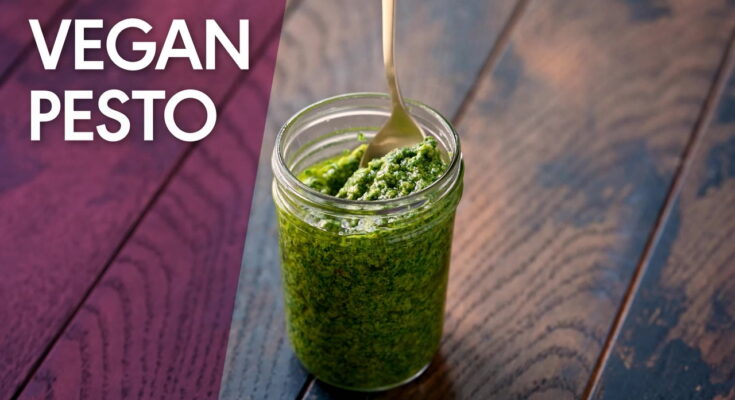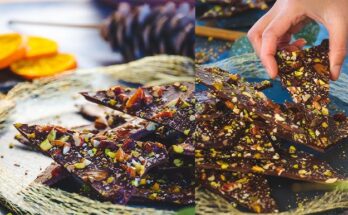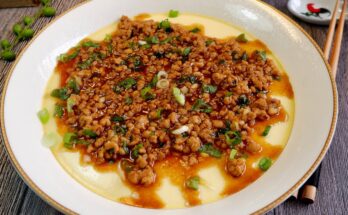Vegan Pesto Recipe: Pesto is one of those magical sauces that transforms the simplest dish into something gourmet. Traditionally hailing from Genoa, Italy, classic pesto is a vibrant green sauce made with fresh basil, garlic, pine nuts, Parmesan cheese, and olive oil. It’s a culinary staple beloved for its bold, herby flavor and creamy texture. But here’s the good news for plant-based eaters—pesto doesn’t need dairy to be delicious. That’s where vegan pesto comes in!
Vegan pesto swaps out the Parmesan cheese and brings in plant-based powerhouses like nutritional yeast, lemon juice, or even avocado to achieve that same rich, umami flavor. The result? A completely dairy-free, flavor-packed, and incredibly versatile sauce that’s as good (if not better) than the original. Whether you’re drizzling it over pasta, spreading it on a sandwich, or using it as a dip, this vegan pesto will quickly become your new go-to.
Plus, it’s a lot more customizable than you might think. Once you master the basic formula, you can play with different herbs, nuts, and add-ins to create your signature pesto blend. Ready to dive into green goodness? Let’s get started!
Ingredients Needed for Vegan Pesto
One of the best things about vegan pesto is how easy and flexible it is. With just a handful of ingredients, you can whip up a fresh batch in under 10 minutes. Here’s what you’ll need:
Basic Ingredients:
- Fresh Basil Leaves (2 cups packed): The star of the show. Always go for fresh, vibrant leaves.
- Pine Nuts (1/3 cup): Classic choice, but can be swapped for other nuts.
- Garlic (2–3 cloves): Adds a punch of flavor.
- Nutritional Yeast (2–3 tbsp): Replaces Parmesan with a cheesy, nutty flavor.
- Lemon Juice (2 tbsp): Adds brightness and a touch of acidity.
- Extra Virgin Olive Oil (1/3–1/2 cup): Gives it that creamy, smooth texture.
- Salt (to taste): Enhances all the flavors.
Optional Add-ins to Elevate Flavor:
- Spinach or Kale (1/2 cup): Great for bulking up without overpowering.
- Avocado (1/2): For an ultra-creamy texture.
- Pepper flakes or black pepper: For a kick of spice.
- Miso Paste (1 tsp): Adds depth and a savory umami hit.
The beauty of pesto is its adaptability. If you’re out of pine nuts, use walnuts, cashews, or almonds. No nutritional yeast? Try a bit of miso or just rely on the garlic and lemon for bold flavor.
Tools and Equipment You’ll Need
You don’t need a full gourmet kitchen setup to make vegan pesto. In fact, most of the equipment you’ll already have in your kitchen.
Must-Have Tools:
- Food Processor or Blender: For blending everything into a smooth, luscious sauce.
- Measuring Cups & Spoons: For accuracy in flavor balance.
- Spatula: To scrape down the sides of your blender or processor.
- Knife and Cutting Board: For prepping garlic and trimming basil if needed.
Nice-to-Have (But Optional):
- Toaster or Skillet: If you’re toasting nuts.
- Mason Jar or Glass Container: For storing your pesto.
If you don’t have a food processor, a high-speed blender will do the trick, though you might need to stop and scrape down the sides more often. A mortar and pestle is the old-school method—it works beautifully but takes a bit more elbow grease.
Step-by-Step Guide to Making Vegan Pesto
Ready to get your hands a little green? Here’s how to make a delicious vegan pesto from scratch, step by step.
Step 1: Gather All Ingredients
Before you start, get everything measured and ready to go. Freshness matters big time with pesto—especially your basil. Choose bright green, unblemished leaves and rinse them gently under cool water. Pat them dry with a clean kitchen towel or paper towels to avoid watery pesto.
Also, make sure your garlic is peeled and your nuts are portioned. Prepping ahead keeps the process smooth and fast.
Step 2: Toast the Nuts (Optional but Recommended)
This step is optional, but it’s a game-changer. Toasting nuts brings out their natural oils and adds a layer of richness that raw nuts just don’t have. Simply toss them in a dry skillet over medium heat for 3–5 minutes until golden and fragrant. Keep an eye on them—they can burn quickly!
Let the nuts cool slightly before adding them to the blender.
Step 3: Blend the Greens and Nuts
Now it’s time to get that pesto going. Start by adding the basil leaves and toasted nuts to your food processor. Give it a few quick pulses to break everything down. This step is crucial for getting the texture just right. If you blend everything all at once, you might end up with a paste instead of a sauce.
Pro tip: If you’re using any extra greens like spinach or kale, this is the time to toss them in. They’ll bulk up the pesto and add more nutrients without taking away from the flavor.
Don’t worry if it looks a little chunky at this point—we’re just getting started. This is the base that will hold all the flavors together. You want a slightly coarse texture here because the next steps will smooth it all out beautifully.
Step 4: Add Garlic, Lemon Juice, and Nutritional Yeast
Next up: flavor bombs. Add your garlic cloves, lemon juice, and nutritional yeast into the processor. Each one of these adds a layer of deliciousness—garlic for that punchy kick, lemon juice for brightness, and nutritional yeast for that cheesy, savory depth that mimics Parmesan.
Pulse a few times, then run the processor until everything starts to look like a rough paste. Taste as you go—every batch of pesto should be a little different based on your preferences. Want it tangier? Add more lemon. Craving that cheesy edge? Toss in another spoonful of nutritional yeast.
This is the step where your pesto really starts to come alive.
Step 5: Slowly Add Olive Oil
Now comes the magic moment—adding olive oil. Turn your food processor on low and slowly drizzle in the olive oil through the feed tube. This helps emulsify the ingredients, giving your pesto that creamy, cohesive texture.
Go slow and steady here. Start with 1/3 cup and increase as needed. You want a smooth sauce that’s not too runny but not too thick. It should cling to pasta but also spread easily on toast or sandwiches.
If you’re looking to reduce oil, you can swap half of it with water or use avocado for creaminess, but keep in mind the flavor and texture might change slightly.
Once you’ve added all the oil, scrape down the sides and give it one final blend. Boom—you’ve got pesto!
Step 6: Taste and Adjust Seasonings
This is where you become the chef. Give your pesto a good taste. Need more salt? Add a pinch. Want more zing? Squeeze a bit more lemon. Garlic not kicking enough? Drop in another half clove and blend.
Customizing at this stage lets you make the pesto perfect for your palate. Some like it bold and garlicky, others prefer a smooth, mellow flavor. There’s no wrong way—just your way.
Once you’re happy, transfer your pesto to a container or serve immediately. Fresh, homemade vegan pesto at its finest.
Storing Your Vegan Pesto
Pesto is best fresh, but it stores beautifully too. Pour it into a glass jar or airtight container and smooth the top with a spoon. To keep it from oxidizing (turning brown), drizzle a thin layer of olive oil over the top before sealing.
Storage Tips:
- Fridge: Keeps fresh for 5–7 days.
- Freezer: Spoon into an ice cube tray for single servings. Once frozen, transfer cubes to a freezer bag. Good for up to 3 months.
- Avoid Metal Containers: Pesto reacts with metal and can alter the taste—stick with glass or plastic.
Quick tip: If you’re freezing, don’t add the lemon juice or nutritional yeast until you’re ready to use. This keeps the flavors brighter and fresher.
Delicious Ways to Use Vegan Pesto
Vegan pesto isn’t just a one-trick pony for pasta—its uses are endless and can elevate almost any dish. Once you have a jar ready, you’ll find yourself adding it to everything. Think of it as the green gold of your kitchen. Here’s how to make the most of every spoonful:
Pasta Dishes
The classic pairing. Toss freshly cooked pasta—hot or cold—with a generous dollop of pesto. You can add sautéed veggies, roasted cherry tomatoes, or vegan cheese for a heartier dish. It also works great in cold pasta salads for picnics or meal prep.
Sandwiches and Wraps
Spread pesto on your favorite sandwich bread, toast, or wrap for a burst of flavor. It pairs beautifully with grilled veggies, tofu, tempeh, or even vegan deli slices. It makes an excellent alternative to mayo or mustard.
Pizza Sauce
Swap out your tomato base and spread pesto over your pizza dough before topping it with roasted veggies and vegan mozzarella. It gives your pizza a gourmet twist that’s hard to resist.
Dip and Dressing
Need a party dip? Blend your pesto with a bit of vegan yogurt or cream cheese for a killer dip. You can also thin it out with a splash of lemon juice or vinegar to turn it into a zesty salad dressing.
Roasted Veggies and Grains
Drizzle pesto over roasted potatoes, cauliflower, or carrots. Stir it into quinoa, rice, or farro for an herbaceous upgrade. It’s also great for grain bowls with beans and greens.
Pesto can turn even the most boring dish into something exciting. Once you start experimenting, you’ll wonder how you ever lived without it.
Nutritional Benefits of Vegan Pesto
Vegan pesto isn’t just delicious—it’s surprisingly good for you, too. Let’s break down what makes it such a powerhouse in the nutrition department.
Healthy Fats
Olive oil and nuts provide monounsaturated fats that support heart health and reduce inflammation. These fats also help your body absorb fat-soluble vitamins like A, D, E, and K.
Vitamins and Minerals
Fresh basil is packed with vitamin K (great for bones and blood clotting), while lemon juice adds vitamin C for immune support. Garlic offers allicin, a compound known for its antibacterial properties.
Nutritional yeast is another hero here—it’s often fortified with B12, which is crucial for energy levels and nerve health, especially in plant-based diets.
Antioxidants
Basil and garlic are loaded with antioxidants, which protect your cells from damage caused by free radicals. This can reduce your risk of chronic diseases like cancer and heart disease.
Low in Carbs
If you’re watching your carb intake, vegan pesto is a keto-friendly option. It’s low in sugar and carbs while being rich in flavor and texture.
Allergy-Friendly
Ditch the cheese, and you’ve got a dairy-free, often gluten-free, and soy-free sauce that fits most dietary needs. You can even make it nut-free by using seeds like sunflower or hemp.
All in all, vegan pesto is not only a flavor enhancer but a nutrient booster. It’s the rare sauce that tastes indulgent but is secretly nourishing.
Common Mistakes to Avoid
Making vegan pesto is simple, but a few common mistakes can mess with the texture or flavor. Here’s what to avoid so your pesto comes out perfect every time:
Using Old or Yellowing Basil
Freshness is key. Wilted or yellow basil can make your pesto taste bitter or bland. Always use the freshest, brightest leaves possible, and never the stems—they can be bitter.
Adding All the Oil at Once
Dumping all the oil in from the start can lead to a greasy or overly thin pesto. Always drizzle it in slowly while blending to create a creamy, well-emulsified sauce.
Over-Blending
Too much blending can overheat the basil and cause it to oxidize faster, turning your pesto a dark, muddy green. Use short pulses or blend on low to preserve the vibrant color.
Skipping the Toasting Step
Toasting nuts enhances their flavor dramatically. Skipping this step might leave your pesto tasting flat or raw. It only takes a few minutes and makes a world of difference.
Forgetting to Taste and Adjust
Pesto isn’t one-size-fits-all. Your lemon might be extra tangy or your garlic super strong. Always taste and tweak—more salt, more acid, or even more garlic can take your pesto from good to unforgettable.
Avoid these pitfalls, and you’ll be whipping up pesto like a pro in no time.
Customizing Your Pesto Recipe
One of the best things about making vegan pesto at home is how easily you can customize it. Once you’ve got the basics down, the possibilities are endless. You can swap, add, or tweak ingredients to match your taste buds, dietary needs, or what you’ve got in the fridge.
Switch Up the Greens
Basil is traditional, but you don’t have to stick with it. Try these substitutes or combos:
- Spinach: Milder flavor and a great way to sneak in extra nutrients.
- Arugula: Adds a peppery punch.
- Kale: Earthy and sturdy, great when balanced with lemon.
- Cilantro: Delicious in Latin-inspired dishes.
- Mint or Parsley: Great for a fresher, lighter twist.
Try Different Nuts or Seeds
Pine nuts are pricey and sometimes hard to find. Luckily, plenty of other options work just as well:
- Walnuts: Rich and earthy—great budget alternative.
- Cashews: Smooth and slightly sweet.
- Almonds: Nutty and crunchy, a classic pick.
- Sunflower seeds or pumpkin seeds: Ideal for nut-free versions.
- Hemp seeds: Adds a protein boost and a slightly grassy flavor.
Change the Acid or Add a Creamy Element
- Swap lemon juice with lime for a zingy twist or add a splash of apple cider vinegar for subtle tang.
- For creaminess without oil, use avocado, vegan mayo, or unsweetened dairy-free yogurt.
- Add a spoonful of miso paste or tamari for savory depth.
Spice It Up
- Add chili flakes, jalapeños, or black pepper for a little heat.
- A touch of smoked paprika or cumin can give it a Mediterranean vibe.
Customizing pesto lets you experiment with endless flavor combinations, making it perfect for everything from Italian night to taco Tuesdays.
FAQs about Vegan Pesto Recipe
1. Can I make vegan pesto without oil?
Yes! You can substitute olive oil with avocado, water, or even vegetable broth for a lower-fat version. Keep in mind the texture will be different, but still delicious.
2. How long does vegan pesto last in the fridge?
Stored in an airtight container with a layer of olive oil on top, it can last 5–7 days in the fridge. For longer storage, freeze it in ice cube trays and use as needed.
3. What can I use instead of nutritional yeast?
Try miso paste for umami, ground sunflower seeds, or simply skip it and use more garlic and lemon for flavor. Vegan Parmesan substitutes also work well.
4. Is vegan pesto kid-friendly?
Absolutely! Just reduce the garlic if your little one is sensitive to strong flavors. You can also add avocado for a creamier, milder taste.
5. Can I use frozen basil for pesto?
Yes, though fresh is best. If using frozen basil, thaw and drain it well to avoid a watery pesto. You may need to adjust the oil and seasoning.
Conclusion
Vegan pesto is more than just a sauce—it’s a lifestyle upgrade. With its bold, fresh flavors, incredible versatility, and simple ingredients, it’s the kind of recipe that you’ll return to again and again. Whether you’re tossing it with pasta, slathering it on a sandwich, or using it as a dip, it brings a burst of green magic to every dish.
Best of all, it’s ridiculously easy to make and endlessly customizable. You don’t need fancy ingredients or a professional kitchen—just a handful of pantry staples, a blender, and a little creativity. From traditional basil and pine nuts to bold experiments with kale, cilantro, and pumpkin seeds, vegan pesto is your blank canvas for culinary creativity.
So, what are you waiting for? Grab some fresh greens, fire up that blender, and get ready to enjoy the most delicious vegan pesto you’ve ever had. Once you go homemade, you’ll never want store-bought again.



